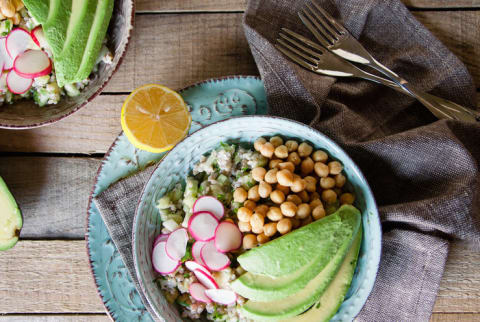Advertisement
How To Build The Ultimate Plant-Based Salad Bowl


Eating salad is a great way to pack lots of vitamins, minerals, antioxidants, phytonutrients, enzymes, and fiber into your diet. But salad can be a very broad term.
Salads aren't always healthy — especially if you add processed dressing or drown your veggies in excess oil.
Salads can also have too few calories and leave you hungry. I remember days when I’d decide to "eat healthy" and just have salad for lunch — my salad would consist of romaine lettuce, cucumbers, tomatoes, and lemon juice.
Sometimes I felt like I was hungrier than before I had eaten, which would lead to bingeing on cookies later.
Here’s my favorite seven-step formula for creating salad bowls that are flavorful, nourishing, and satisfying.
There’s no right or wrong way to make a salad. If you have any tips and tricks for creating your own salad bowls, please make sure to let the community know in the comments below.
1. Bed of leafy greens
Start with green leafy veggies as a base. Use one or any combination of:
- spinach
- kale
- chard
- dandelion greens
- lettuce
- baby mixed greens
- watercress
- arugula
- shredded cabbage
Include as much of the greens as you think can fit in your stomach. It’s pretty much impossible to overeat leafy greens!
2. Raw vegetables
Add any raw veggies you'd like; these are great additions:
- tomatoes
- cucumbers
- beetroot (grated and marinated in lemon juice)
- cauliflower
- grated carrot
- zucchini
- jicama
- bell pepper
- sprouts
- avocado
3. Lightly cooked vegetables
You can skip this step if you want to make a raw salad. I sometimes like to add some cooked veggies, especially in the colder months of the year.
Steamed broccoli and pumpkin is my favorite combination. But you can also choose from steamed, boiled, or baked:
- sweet potato
- mushrooms
- cauliflower
- zucchini
- Brussels sprouts
- other favorite vegetables
4. Legumes
Adding beans or lentils to a salad bowl makes your dish more filling and nourishing, as legumes are rich in protein, iron, and fiber.
Consider adding:
- red kidney beans
- black beans
- lima beans
- mung beans
- chickpeas
- lentils
Tip: Soak beans overnight before cooking. This reduces the amount of enzyme inhibitors in beans, which makes them more digestible and makes it easier for you to absorb their nutrients.
You can also whip up a hummus — try this oil-free creamy hummus recipe.
5. Seeds or nuts
If you want to boost nutrient content and add crunchiness to your dish, add some raw:
- sunflower seeds
- pumpkin seeds
- hemp seeds
- sesame seeds
- almonds
- walnuts
- pecans
6. Dressing
If you add a lot of different ingredients and hummus to your salad bowl, you can simply use some lemon or lime juice as your dressing.
Or mix up some homemade dressing:
Avoid store-bought dressings, as they usually contain preservatives and other not-so-healthy ingredients.
7. Herbs and spices
Top it all with:
- Himalayan or sea salt
- freshly ground pepper
- fresh or dried herbs
- minced garlic
- ginger
- any spices you like
There are no rules about what you can throw into your salad bowl. Just go with what’s available in your pantry and follow your creativity and intuition. The possibilities are endless. Get creative and make yourself a nourishing lunch — your body will thank you!